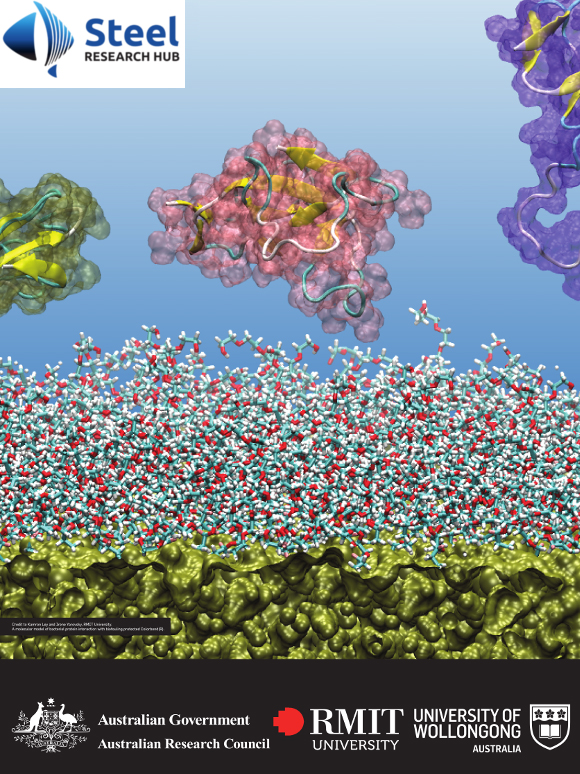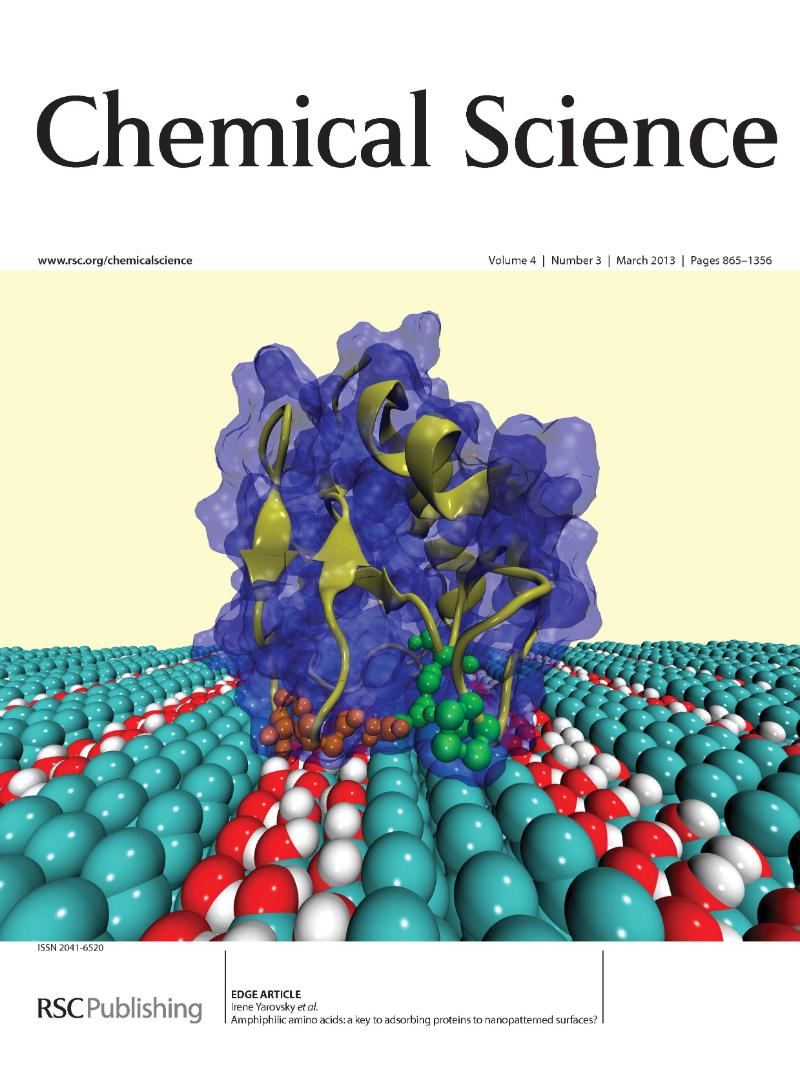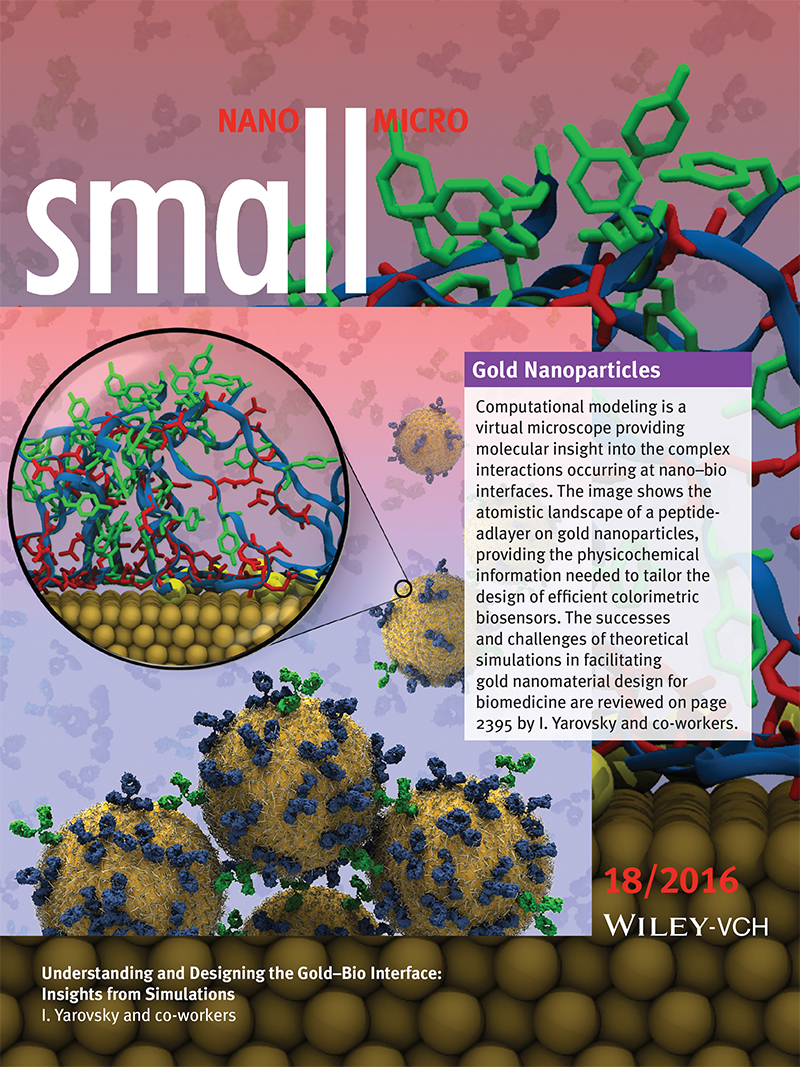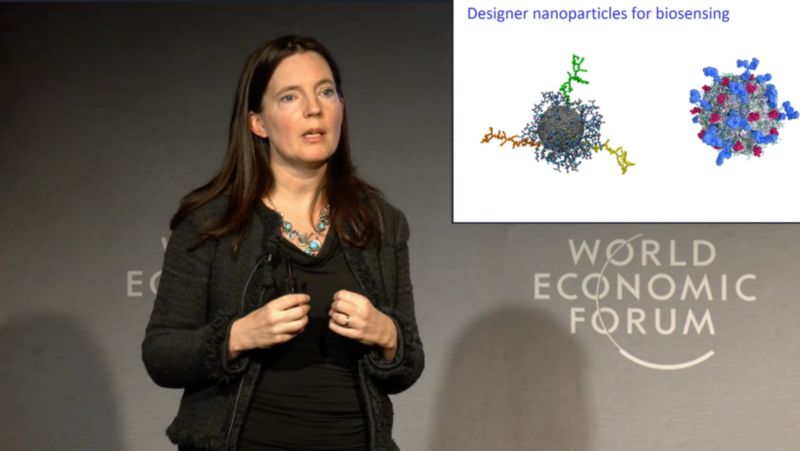This project will develop fundamental principles to guide the design of efficient and safe nanomaterials for biomedical applications, including biosensors, drug delivery and regenerative medicine.

![A) Gold NP colourimetric sensor design [see ref. 1 and 4]; B) Fluorescent gold NP sensor; C) Graphene oxide for amyloid inhibition.](/content/dam/rmit/rmit-images/college-of-seh-images/school-images/engineering/old-schools/samme/Discovery_Stevens-noLayers-1440x865.jpg) A) Gold NP colourimetric sensor design [see ref. 1 and 4]; B) Fluorescent gold NP sensor; C) Graphene oxide for amyloid inhibition.
A) Gold NP colourimetric sensor design [see ref. 1 and 4]; B) Fluorescent gold NP sensor; C) Graphene oxide for amyloid inhibition.
In collaboration, with Professor Molly Stevens' group at Imperial College London, our team conducts fundamental theoretical modelling studies of the molecular structure and dynamics of engineered nanoparticles in biological environment, including proteins, peptides and biological membranes.
The latest techniques in computational modelling of biomolecules at all-atom resolution are employed to explore the molecular mechanisms of biomolecular response to the presence of functionalised nanoparticles.
The studies will enable rational design of novel nanomaterials with high target selectivity and efficient functionality as well as will help understand potential other health implications of engineered nanoparticles.
 Amphiphilic amino acids: a key to adsorbing proteins to nanopatterned surfaces? A. Hung, M. Mager, M. Hembury, F. Stellacci, M. M. Stevens, I. Yarovsky, Chemical Science, 4 (2013) 928 – 937
Amphiphilic amino acids: a key to adsorbing proteins to nanopatterned surfaces? A. Hung, M. Mager, M. Hembury, F. Stellacci, M. M. Stevens, I. Yarovsky, Chemical Science, 4 (2013) 928 – 937
 P. Charchar, A. J. Christofferson, N. Todorova, I. Yarovsky “Understanding and Designing the Gold-Bio Interface: Insights from Simulations” Small, 12 (18), pp 2395-2418 (2016), frontispiece cover
P. Charchar, A. J. Christofferson, N. Todorova, I. Yarovsky “Understanding and Designing the Gold-Bio Interface: Insights from Simulations” Small, 12 (18), pp 2395-2418 (2016), frontispiece cover
Our research collaborator and Partner Investigator on the ARC Discovery grants Professor Molly Stevens from Imperial College London featured our Gold Nanoparticle model in her talk on Biosensors and the Future of Diagnostics at the World Economic Forum 2020 in Davos (Switzerland).

Grants and funding
Key people
- Professor Irene Yarovsky, Chief Investigator and team leader
- Dr Patrick Charchar, Research Fellow
- Dr. Matthew Penna, Research Fellow
- Dr. Ben Noble, Research Fellow
- Jacky Peng, PhD student
- Dr Nevena Todorova, Research Fellow
- Dr Harun Rashid, Research Fellow (2014 - 2018)
- Dr Andrew Christofferson, Research Fellow (2012-2019)
Partners
- Professor Molly Stevens, Imperial College London, UK
- Professor Mike Finnis, Imperial College London, UK
- Surface enhanced Raman scattering artificial nose for high dimensionality fingerprinting, N. Kim, M. R. Thomas, M. S. Bergholt, I. Pence, H. Seong, P. Charchar, N. Todorova, A. Nagelkerke, A. Belessiotis-Richards, D. J. Payne, A. Gelmi, I. Yarovsky, M. M. Stevens, Nature Communications, 11 (2020) 1-12
- The enigma of amyloid forming proteins: challenges and insights from molecular simulations, N. Todorova and I. Yarovsky, Australian Journal of Chemistry, invited review, RACI Awards special issue, 72 (2019) 574-584
- Residue-Specific Solvation Directed Thermodynamic and Kinetic Control over Peptide Self-Assembly with 1D/2D Structure Selection, Y. Lin, M. Penna, M. R. Thomas, V. Leonardo, Y. Wang, E. T. Pashuck, I. Yarovsky, M. M. Stevens, ACS Nano, 13 (2019) 1900-1909
- Surface Dynamics and Ligand-Core Interactions of Quantum Sized Photoluminescent Gold Nanoclusters, Y. Lin, P. Charchar, A. J. Christofferson, M. R. Thomas, N. Todorova, M.M. Mazo, Q. Chen, J. Doutch, R. Richardson, I. Yarovsky, M. M. Stevens, J. Am. Chem. Soc., 140 (2018) 18217-18226
- Effect of size and functionalization on structure and properties of graphene oxide nanoflakes: an in silico investigation, E. Peng, N. Todorova and I. Yarovsky, ACS Omega, 3 (2018) 11497-11503
- Fate of POPC Liposomes in Presence of Phospholipase C and D: From Atomic to Supramolecular Lipid Arrangement, M. N. Holme, M. H. Rashid, M. R. Thomas, H. G. M. Barriga, K. –L. Herpolt, H. Xie, R. K. Heenan, I. Yarovsky and M. M. Stevens, ACS Central Science, 4 (2018) 1023-1030
- Effects of forcefield and sampling method in all-atom simulations of inherently disordered proteins: application to conformational preferences of human amylin, E. Peng, N. Todorova, I. Yarovsky, PLoS ONE, 12(10), 2017, e0186219
- Exploring proton diffusion across insulin amyloid fibril surfaces by naphthol-based photoacid fluorescence and molecular simulations, N. Amdursky, M. H. Rashid, M.M. Stevens and I. Yarovsky, Scientific Reports, 7 (2017) 6245
- Distinct Bimodal Roles of Aromatic Molecules in Controlling Gold Nanorod Growth for Biosensing, J. H. Soh, Y. Lin, M. R. Thomas, N. Todorova, C. Kallepitis, I. Yarovsky, J.Y. Ying, M.M. Stevens, Advanced Functional Materials 27 (2017) 1700523
- Facet dependent Amylin interactions with gold nanoparticles: implications for fibril formation and cytotoxicity, S. Wang, Y. Lin, N. Todorova, M. Mazo, S. Rana, Y. Xu, V. Leonardo, N. Amdursky, I. Yarovsky, M.M. Stevens, Chemistry of Materials, 29 (2017) 1550-1560
- INVITED REVIEW: Understanding and designing the gold-bio interface: insights from simulations, P. Charchar, A. Christofferson, N. Todorova, and I. Yarovsky, Small, 12 (2016) 2395-2418, Frontpiece cover
- Designing peptide nanosensors with dual specificity for the detection of HIV-1 protease, K.-L. Herpoldt, A. Artzy-Schnirman, A.J. Christofferson, A.J. Makarucha, R. de la Rica, I. Yarovsky, M. M. Stevens, Chemistry of Materials, 27 (2015) 7187−7195
- Layer-by-Layer Self-Assembly of polymer films and capsules through Coiled-Coil Peptides, A. J. Gormley, R. Chandrawati, A. J. Christofferson, C. Loynachan, C. Jumeaux, A. Artzy-Schnirman, D. Aili, I. Yarovsky, M. M. Stevens, Chemistry of Materials, 27 (2015) 5820−5824
- Surface presentation of functional peptides determines cell internalization efficiency of TAT modified nanoparticles, N. Todorova, C. Ciapini, M. Mager, B. Simona, I. I. Patel, M. M. Stevens, and I. Yarovsky, Nano Letters, 14 (2014) 5229−5237
- Epitope-tagged gold nanoparticles in immune complex forming systems: on feasibility, mechanism and limitations of single-step immunoassays, H. Andresen, M. Mager, M. Grießner, P. Charchar, N. Todorova, N. Bell, G. Theocharidis, S. Bertazzo, I. Yarovsky, M. M. Stevens, Chemistry of Materials, 26 (2014) 4696-4704
- Dimensionality of carbon nanomaterials determines the aggregation propensity of amyloidogenic peptides, N. Todorova, A. J. Makarucha, N. Hine, A. Mostofi, and I. Yarovsky PLoS Comp Biology, 9(12): e1003360, (2013)
- Amphiphilic amino acids: a key to adsorbing proteins to nanopatterned surfaces?, A. Hung, M. Mager, M. Hembury, F. Stellacci, M. M. Stevens, and I. Yarovsky, Chemical Science, 4 (2013) 928 - 937, Edge article, front cover
- Nanomaterials in biological environment: a review of computer modelling studies, A.J. Makarucha, N. Todorova and I. Yarovsky, Eur. Biophysics Journal, 40 (2011)103-115
- Ordering Surfaces on the Nanoscale: implications for protein adsorption, A. Hung, S. Mwenifumbo, M. Mager, J. Kuna, M. Hembury, F. Stellacci, I. Yarovsky and M. M. Stevens, Journal of the American Chemical Society, 133 (5) (2011) 1438–1450


